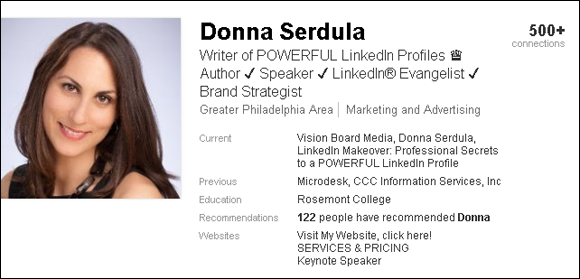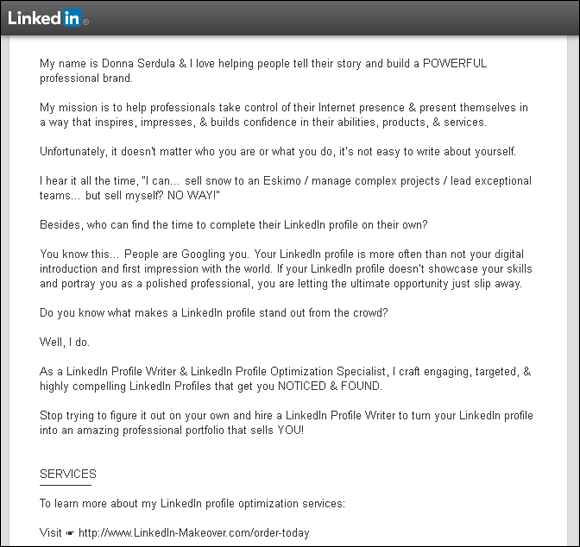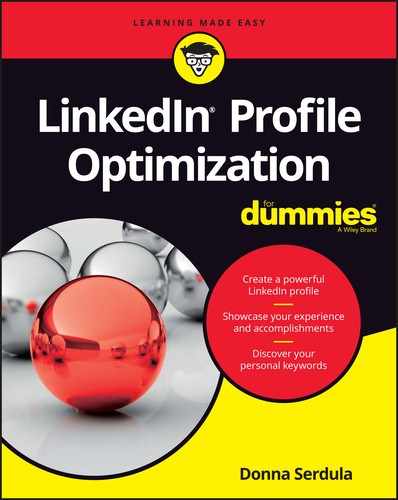Chapter 1
Determining Your LinkedIn Strategy
IN THIS CHAPTER
![]() Deciding your LinkedIn goal
Deciding your LinkedIn goal
![]() Understanding your target audience
Understanding your target audience
![]() Using the proper tone
Using the proper tone
When you register for a LinkedIn account, the first thing you encounter is the LinkedIn profile. Most people jump in and immediately fill out the fields of the profile, not giving much thought as to why they are on LinkedIn or who will eventually be reading their profile.
Profiles created without a goal or a target audience in mind lack purpose. These profiles don’t catch readers’ eyes and compel them to reach out to the person behind the online persona. You see these profiles on LinkedIn every day. Scanning the profile, nothing grabs you or makes you want to learn more about that person.
To experience success on LinkedIn, you must approach your LinkedIn profile strategically. In this chapter, I show you how to determine your LinkedIn strategy by looking at the three most typical goals people are trying to accomplish on LinkedIn. Once you’ve determined your goal, I show you how to figure out your target audience and discuss the importance of creating a compelling profile tone.
Determining Your LinkedIn Goal
To create a profile that has purpose, you must ask yourself, “What am I trying to accomplish on LinkedIn?” Many people get a LinkedIn account because they want to find a new job. Other people are interested in reputation management and branding. Still other people are on LinkedIn because they are in sales and want to prospect and increase sales through social selling.
To help you determine what you want your profile to accomplish, review the following three most common types of LinkedIn profiles.
Job search
LinkedIn plays a huge role in the job search process. Recruiters, hiring managers, and human resources professionals search LinkedIn looking for potential candidates. They may perform broad-based keyword searches looking for a candidate that matches the skill sets the position requires, or they may already have certain candidates in mind. When they have a person already in mind for a position, a name search is performed on LinkedIn with the goal of learning more about that person than what is stated on his or her resume.
LinkedIn is also a job board. The LinkedIn Jobs section (www.linkedin.com/jobs) is where thousands of jobs from all over the world are posted. These job postings are promoted throughout LinkedIn as well. When you find a job posting that interests you, you can apply for the position by submitting your resume and LinkedIn profile.
Potential employers are looking at your profile. The good news is you have control over how you represent yourself and how they perceive you. A job search profile complements and echoes your resume without being a direct one-to-one copy. The profile is written to the job description of that next position you are targeting and showcases you as the perfect candidate for that role.
To find out more about how to create a powerful job search profile, see Chapter 9.
Reputation management and branding
It’s a Google world. At one time, if you needed to find out information, you headed to the library to search the encyclopedias and other reference materials. Now, all you need to do is pull up a web browser and perform an Internet search to get more information than you could ever read or use.
This easy access to information has some side effects. People are doing more research than ever before and they are researching you! Going to the doctor? Most people search the Internet for the doctor’s name to see the results that pop up in a search engine. Executives who find their names appearing in press releases or in magazine articles may find that views to their LinkedIn profiles skyrocket by readers wanting to know more about them.
Job candidates’ names are entered into search engines all the time by hiring managers looking to discover more than what is provided in the resume. Similarly, hiring managers’ names are searched by job candidates wanting to learn more about their potential new employer.
LinkedIn profiles rank high in search results. Not only is it usually the top result when a person searches for your name, but also it’s sometimes the only result, as most people don’t have a personal website. You create your LinkedIn profile. You choose what people learn about you. You have total control over how people perceive you. A reputation management profile is one that showcases your successes, honors, awards, and accomplishments, and leads people to see you as a credible, impressive professional. See Figure 1-1 for an example.

FIGURE 1-1: A reputation management and branding profile.
Sales and prospecting
LinkedIn is more than just a job search tool. LinkedIn is a compendium of professional profiles with industry and contact information, which makes it a terrific prospecting tool for sales professionals. However, it’s not just for sales people looking for prospects. People use LinkedIn to search for service providers and consultants who can help them.
Most people prefer to do business with someone they know or someone with whom they share a connection. When searching LinkedIn for a service provider, you see how you are connected to that service provider through the degrees of connection. This ability to see shared connections provides a level of trust and comfort.
A sales and prospecting profile shines the spotlight on not just the salesperson, but also on that person’s products, services, and company he or she represents. Most important, the sales and prospecting profile focuses on prospective clients and their needs, and solidifies the salesperson as someone clients can feel confident in working with. See Figure 1-2 for an example.

FIGURE 1-2: A sales and prospecting profile.
Figuring Out Your Target Audience
Knowing your goal is only half the battle. Now it’s time to figure out your target audience. One of the most common mistakes people make with their LinkedIn profiles is using it to tell the story they want to tell. Instead, you need to use your profile to tell the story your audience wants to read. Write for your target audience first.
When you are looking for a job, your target audience is typically recruiters, hiring managers, and human resources professionals. In almost every case, they are armed with a job description. Recruiters want to know that you have the skill sets and experience required to fulfill the job. They also want to know that you are professional, respectful, and capable of doing the job. You want to make it clear in your profile that you are the perfect person for your desired position. After reading your profile, the recruiter should feel confident in your skills and abilities.
When you are on LinkedIn for sales and prospecting, your target audience is your client and prospective client. They are less interested in hearing about your sales expertise and more interested in knowing that you understand their industry and their needs, and can provide solutions to their issues. As you consider your target audience, think in terms of the solutions you offer them and provide them the information they need to feel confident with you as a potential partner.
The sales world has changed in the age of Google and social media. Buyers now educate themselves, researching products and services online. They even research the salesperson, wanting to make sure they are reaching out to someone they can feel comfortable working with. Knowing that you are under a magnifying glass, make sure you provide your target audience with the information they need to feel confident in you and your products or services.
When the goal of your LinkedIn profile is reputation management and branding, your target audience may not be as clear cut as it is with a job search or sale and prospecting. To figure out your audience, you need to determine the type of person you want to cater your profile toward. Is it the executive team and colleagues at your company? Audience members who watched you give a presentation? Readers of articles you wrote? Private equity investors? Once you pinpoint the type of person who you want to target, consider what that person needs to know to take that next step forward.
Do you want your target audience to connect with you on LinkedIn? Perhaps you want them to visit your website and download a whitepaper. You may want your target audience to email you to request your resume. Your target audience could pick up the phone and call you. Figure out what that next step is so you can build it into your profile as a clear call to action.
Creating a Compelling Tone
LinkedIn is a social network, and writing an impersonal profile filled with business jargon doesn’t mesh. Social networks are all about you interacting with your network. And because your network will check out your profile, it’s imperative that what they read is from your pen. You don’t want to push people away by creating distance between you and your reader.
A powerful LinkedIn profile is written in first person narrative form (“I”). Draw readers in by writing about yourself in the first person. Writing in a conversational, natural tone is a great way to connect with your audience and start forging an easy rapport.
As important as it is to write in first person, you also must be careful not to overuse “I.” There is nothing worse than a profile where every sentence starts with I. In my profile, I sometimes use the second person narrative form (“You”) because it brings your reader in even closer by speaking directly to them, and it eases the potential overuse of “I.”
Here is an example of stilted, hard-to-read resume speak:
Creating a clear strategy for leveraging resources to produce the maximum number of insights possible. Integrating contextual analytics to business processes. Centralizing deep analysis expertise for use across the organizational axis but mandating each individual department and line of business takes responsibility for their own reporting needs.
When you see profiles written in the third person, typically the reason is that they simply copied and pasted their biography or resume into the LinkedIn profile. That’s a cop-out! Your LinkedIn profile is not your resume nor your bio. Your LinkedIn profile is your career future! It’s who you are, how you help people, and why you deserve to be noticed. A powerful LinkedIn profile is strategically written for your goals and your target audience. It’s not a copy and paste of some other document.
Next up we look at how to get found on LinkedIn.

 Even if you aren’t utilizing LinkedIn’s job postings or hoping to collide with a recruiter, potential employers are still looking you up on LinkedIn and reviewing your LinkedIn profile. Think about it: If you are about to hire someone, and available to you is a database in which to look this person up and see a picture of the candidate, a listing of people he or she knows, and recommendations of his or her work ethic, of course you would use it!
Even if you aren’t utilizing LinkedIn’s job postings or hoping to collide with a recruiter, potential employers are still looking you up on LinkedIn and reviewing your LinkedIn profile. Think about it: If you are about to hire someone, and available to you is a database in which to look this person up and see a picture of the candidate, a listing of people he or she knows, and recommendations of his or her work ethic, of course you would use it! You want to write your profile as if you are talking directly to your reader. Your words should sound professional yet natural. A profile written in corporate jargon or resume speak is a turn off. Demonstrate your human side and warmth by writing in a natural, conversational tone.
You want to write your profile as if you are talking directly to your reader. Your words should sound professional yet natural. A profile written in corporate jargon or resume speak is a turn off. Demonstrate your human side and warmth by writing in a natural, conversational tone.